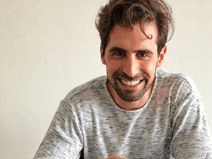The Challenge: A Severe Headache and Brain Hemorrhage
After completing medical school plus three demanding years in a residency program, Dr. Isaac Cohen felt ready. He was eager to start the next chapter in his career as an anesthesiologist.
But after working only two months as an attending physician in a Florida hospital, he got a headache that progressively grew worse.
“My headache became severe and unbearable. So, I called my colleagues and asked them to take me to the Emergency Room,” Dr. Cohen says.
Scans showed that Dr. Cohen was suffering from a brain hemorrhage, or bleeding inside his brain stem.
Schedule an Appointment or Ask a Question
At only 31 years old, Dr. Cohen never imagined he would have such a serious health scare at that age.
Due to the bleeding, he lost mobility on the left side of his body and spent nearly three weeks in the hospital.
“I was learning how to talk and swallow again,” says Dr. Cohen. “I got to the point where I was healthy enough to leave the hospital. But there was no way I was able to perform my job as a physician and anesthesiologist. I wasn’t going to be able to return to work unless I figured out what caused the bleeding.”
The Path to UPMC: Research and Advice
After researching his problem, Dr. Cohen suspected he had a cavernous malformation or cavernoma. A cavernous malformation is a group of abnormal blood vessels that can lead to serious neurological symptoms.
He reached out to his network of colleagues asking for advice about who could help. The name he heard several times was the chair of the Department of Neurosurgery at UPMC.
“I emailed the neurosurgeon, and eventually we spoke on the phone. We are both Venezuelan, so we formed a connection before we ever met. I trusted him. And my research also showed he was one of the best in treating these types of problems,” says Dr. Cohen.
Soon after making an appointment to see the neurosurgeon at the end of the year, Dr. Cohen had a second brain hemorrhage. Days later, he traveled to Pittsburgh to meet.
The Solution: Brain Mapping and Surgery
To fully understand Dr. Cohen’s condition, the neurosurgeon used special brain mapping technology called high definition fiber tracking (HDFT). Developed at the University of Pittsburgh, HDFT takes 3D images of the brain's fibers.
The neurosurgeon confirmed that Dr. Cohen did have a cavernous malformation and scheduled him for surgery the next day. With HDFT, he could pinpoint the exact location of the malformation and which nerves it was pressing on. He could then decide the best approach to surgery to remove the abnormality.
As a doctor himself, Dr. Cohen wasn’t used to being on the other side of the doctor-patient relationship.
“It was a surreal experience to be the patient and the one getting anesthesia. I had never undergone surgery myself before,” Dr. Cohen explains. “It was a delicate operation with risks, but I trusted the neurosurgeon. And I didn’t want to live my life with those symptoms holding me back.”
The Results: Feeling Great and Leading an Active Life
Dr. Cohen had an operation to remove the blood that was lodged in his brain stem. Soon after, he noticed that many of his symptoms linked to balance, coordination, and speech quickly improved.
A week later, Dr. Cohen had a second operation to remove the cavernoma.
Today, Dr. Cohen is feeling great and enjoying his life. He's very active, working out and running. Best of all? He’s back to work.
“I really thought my career as an anesthesiologist was going to be short lived. I never thought I would be back to work so soon,” says Dr. Cohen.
At a recent event, Dr. Cohen ran into the neurosurgeon and was overcome with emotion.
“I’m extremely grateful I went to UPMC and met the chair of the Department of Neurosurgery, his residents, and his staff. It was one of the best decisions I’ve made in my life,” he says.
Our patient stories profile a number of patients who have had minimally invasive brain surgery at UPMC. Although everyone's care experience is unique, we hope that sharing these stories will help other prospective patients and their families better understand these procedures and their potential benefits.
Dr. Cohen's treatment and results may not be representative of all similar cases.

















